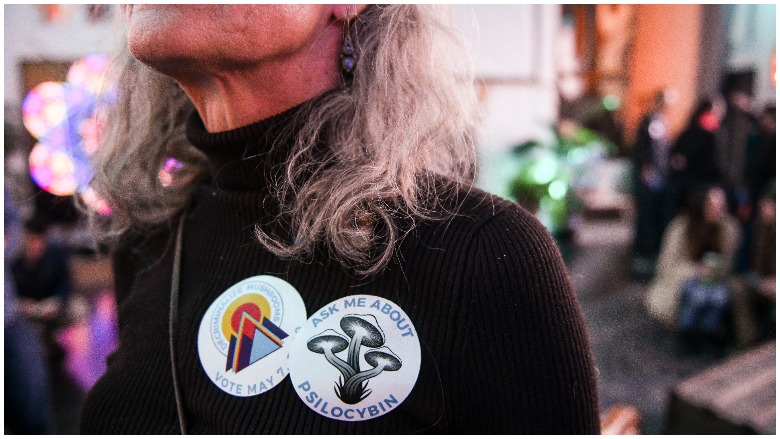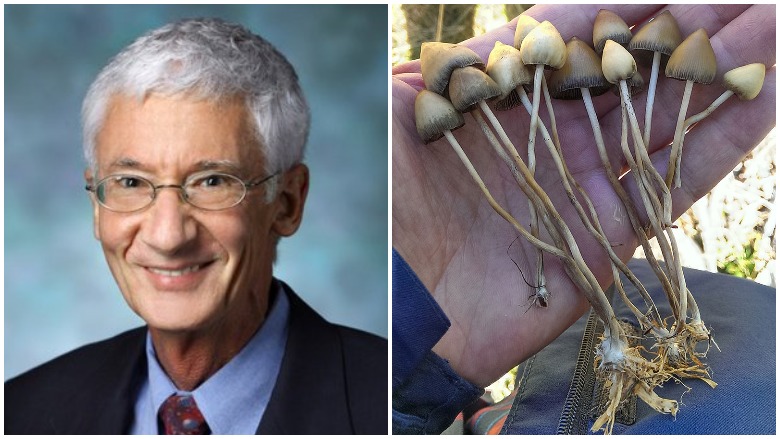
Getty A woman attends an event to decriminalize psilocybin in Denver, Colorado.
Psilocybin, more commonly known as “magic mushrooms,” “shrooms” or simply “mushrooms,” is a psychedelic drug which was outlawed as a substance with no legitimate medical purpose in the Controlled Substances Act of 1970.
However, the medical benefits of psilocybin were being studied before the ban, and studies were halted once the Controlled Substances Act was signed into law. Studies resumed 30 years after the law was signed by President Richard Nixon. Studies are now being conducted into whether the substance, known as a party drug from the counterculture, can help reduce death anxiety in cancer patients. In ancient times, psilocybin was considered a substance that promoted healing and spiritual connectedness. It is this quality that researchers like Roland Griffiths believe may help people in modern society, as long as risk factors are controlled.
The study, its lead researcher, Roland Griffiths of Johns Hopkins University, and one of its participants, Kerry Pappas, are featured on the October 13, 2019 episode of 60 Minutes. It airs at 7:30 p.m. EST on CBS.
Here’s what you need to know:
1. Effects of Psilocybin Were Studied Until Controlled Substances Act of 1970
Psilocybin and its effects were the subjects of research and studies, but those projects were effectively banned by the Controlled Substances Act, which was signed into law by President Richard Nixon.
Several studies were conducted in the late 1960s and 1970s that showed psilocybin might be effective in treating mood disorders in cancer patients, but they required further research, Johns Hopkins University researchers wrote in their study published in 2016.
“Several unblinded studies in the 1960s and 70s suggested that such compounds might be effective in treating psychological distress in cancer patients (Grof et al., 1973; Kast, 1967; Richards et al., 1977); however, these studies did not include the comparison conditions that would be expected of modern psychopharmacology trials,” the researchers wrote. “Subsequently, human research with these compounds was halted for almost three decades because of safety and other concerns raised in response to widespread non-medical use in the 1960s. Recent resumption of clinical research with these compounds has established conditions for safe administration (Johnson et al., 2008; Studerus et al., 2011).”
Research projects in other countries were being conducted, such as trials in the United Kingdom and Switzerland, according to the Multidisciplinary Association for Psychedelic Studies.
“Such studies have been largely dormant since the Controlled Substances Act of 1970, which effectively ended most medical research on psychedelics,” writes SciPol, a Duke University Science and Technology publication of studies in the United States. “That, of course, came amid the fallout from widespread abuse of LSD, which had its roots partly in medical experiments that were led by the Harvard psychologist Timothy Leary.”
The law classifies psilocybin as a substance with no legitimate medical purpose and high potential for abuse. Justice.gov notes that psilocybin, often called “magic mushrooms” or “shrooms,” is often abused at raves, clubs and college campuses. The effects last about six hours.
2. Psilocybin is Classified as a Schedule 1 Controlled Substance, Meaning it Has No Medical Benefit According to Law
Psilocybin is a Schedule 1 controlled substance, according to Justice.gov. Schedule 1 drugs have high potential for abuse and serve no legitimate purpose. Schedule 1 drugs include heroin and LSD. Tetrahydrocannabinol, or THC, the psychoactive ingredient in marijuana, is still a Schedule 1 controlled substance under federal law, even though some states have legalized it, decriminalized it or signed laws to make medical marijuana legal.
“Psilocybin is a Schedule I substance under the Controlled Substances Act,” Justice.gov says. “Schedule I drugs, which include heroin and LSD, have a high potential for abuse and serve no legitimate medical purpose in the United States.”
Drugs are classified based on their addictive potential and dangers, potential for abuse and accepted medical uses in the country.
Justice.gov says, “Psilocybin mushrooms are popular at raves, clubs and, increasingly, on college campuses and generally are abused by teenagers and young adults. It is difficult to gauge the extent of psilocybin use in the United States because most data sources that quantify drug use exclude psilocybin. The Monitoring the Future Survey, conducted by the University of Michigan, does reveal that 9.2 percent of high school seniors in the United States used hallucinogens other than LSD–a category that includes psilocybin–at least once in their lifetime. Two percent of high school seniors used hallucinogens other than LSD in the past month.”
3. Johns Hopkins & NYU Conducted Studies Published in the Journal of Psychopharmacology in 2016
Johns Hopkins University and New York University conducted similar but separate studies on the effects of drugs on cancer patients who are experiencing death anxiety and depression. The NYU study used niacin. The Johns Hopkins University study was conducted by Roland Griffiths and others, and published in the Journal of Psychopharmacology November 30, 2016. You can read the full study here.
“Cancer patients often develop chronic, clinically significant symptoms of depression and anxiety,” the abstract says. “Previous studies suggest that psilocybin may decrease depression and anxiety in cancer patients. The effects of psilocybin were studied in 51 cancer patients with life-threatening diagnoses and symptoms of depression and/or anxiety.”
The study was a double-blind cross-over trial. Some participants received a very low, placebo-like dosage. The study involved multiple sessions with 5 weeks in between and a 6-month followup.
The study found there were no adverse effects on patients, the researchers wrote.
4. Johns Hopkins University Study Found Cancer Patients Had ‘Substantial & Sustained’ Decreases in Depression & Anxiety

Johns Hopkins Medicine/Wikimedia CommonsRoland Griffths/psilocybin mushrooms
The Johns Hopkins University study found psilocybin “produces substantial and sustained decreases in depression and anxiety in patients with life-threatening cancer” following its trial. The study was published November 30, 2016, in the Journal of Phsychopharmacology. The trial involved 51 patients and included a six month followup which asked participants about their quality of life, optimism, acceptance of death and other factors.
“The data show that psilocybin produced large and significant decreases in clinician-rated and self-rated measures of depression, anxiety or mood disturbance, and increases in measures of quality of life, life meaning, death acceptance, and optimism,” the study said. “These effects were sustained at 6 months. For the clinician-rated measures of depression and anxiety, respectively, the overall rate of clinical response at 6 months was 78% and 83% and the overall rate of symptom remission was 65% and 57%. Participants attributed to the high-dose experience positive changes in attitudes about life, self, mood, relationships and spirituality, with over 80% endorsing moderately or higher increased well-being or life satisfaction. These positive effects were reflected in significant corresponding changes in ratings by community observers (friends, family, work colleagues) of participant attitudes and behavior.”
The trial was considered Phase 2 of the project. Roland Griffiths told SciPol he would like to conduct a much larger study involving many more participants at sites throughout the country. However, that trial, considered Phase 3, would cost $20 to $40 million.
5. Psilocybin, More Commonly Called ‘Magic Mushrooms,’ ‘Shrooms’ or ‘Mushrooms,’ Is Commonly Associated With Raves, Clubs & the Counterculture
Psilocybin, which is typically referred to as “magic mushrooms,” “shrooms” or “mushrooms” when it is being used as a recreational drug, is most commonly associated with the counterculture in the ’60s and with raves and clubs. It is a psychedelic drug which can cause hallucinations and significantly altered perceptions of reality. The effects can last six hours.
The Controlled Substances Act of 1970 classified psilocybin as a Schedule 1 controlled substance, meaning it is considered to have high abuse potential and no medical benefits. Justice.gov notes it there is not evidence of chemical dependence, or addiction, but frequent users can develop a tolerance for it.
The Justice.gov page for psilocybin says:
Use of psilocybin is associated with negative physical and psychological consequences. The physical effects, which appear within 20 minutes of ingestion and last approximately 6 hours, include nausea, vomiting, muscle weakness, drowsiness, and lack of coordination. While there is no evidence that users may become physically dependent on psilocybin, tolerance for the drug does develop when it is ingested continuously over a short period of time.
The psychological consequences of psilocybin use include hallucinations and an inability to discern fantasy from reality. Panic reactions and psychosis also may occur, particularly if a user ingests a large dose.
In addition to the risks associated with ingestion of psilocybin, individuals who seek to abuse psilocybin mushrooms also risk poisoning if one of the many varieties of poisonous mushrooms is incorrectly identified as a psilocybin mushroom.
READ NEXT: Lead Psilocybin Researcher Roland Griffiths: 5 Fast Facts You Need to Know